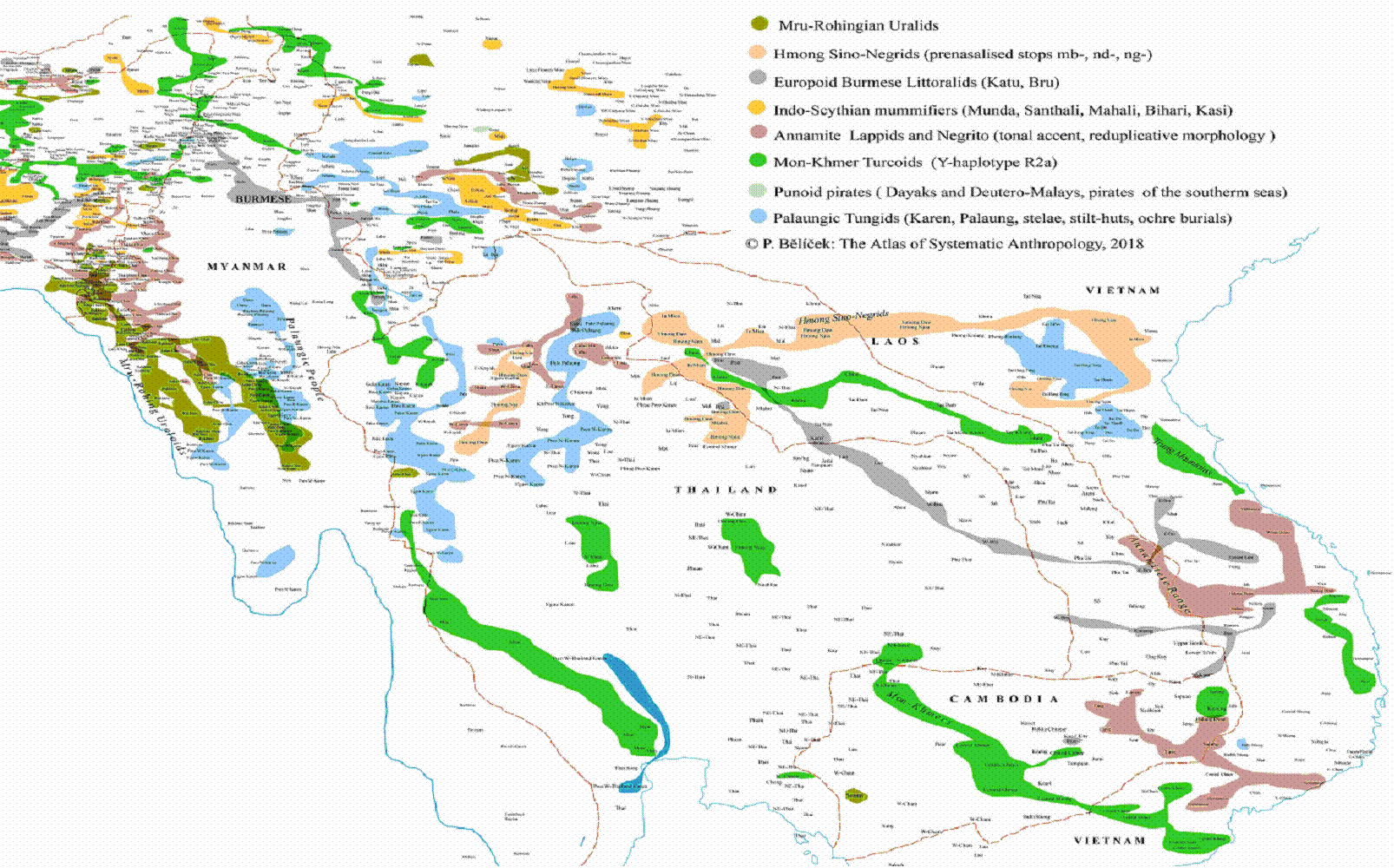|
|
||||||||
|
|
||||||||
|
|
||||||||
|
|
||||||||
|
|
||||||||
|
The
Tribal Composition of Indochina Clickable terms are red on yellow background |
||||||||
|
A map of Indochinese Linguonyms (from P.
Bělíček: The Differential
Analysis of the Wordwide Human Varieties. Prague 2018, p. 151) |
||||||||
The Sino-Tibetan, Tibeto-Burmese and Austroasiatic Ethnic
Family
Modern national mother tongues inevitably provide misleading guidance
for ethnic and racial determination because they originated in the Middle Ages
as an official written standard of administrative communication. In most
civilised cultures they were imposed on folk commoners by the ruling
dynasties of foreign invaders. In shortage of ancient manuscripts linguists
seldom consult historical sources and archaeological finds, let alone ethnic
folk customs. Ethnology, anthropology, raceology
and religionistics accept linguistic speculations
without distinguishing short-term dynastic fashions and long-term folk
customs. Temporary official fashions in culture and language perish, while
popular customs remain permanent and endure through time. National languages,
monumental architecture, official art, royal vestment, court etiquette, manor
parlance and cuisine belong to short-term temporary indicators of ethnicity,
as their duration is restrained to a brief period of reigning royal
dynasties. Prehistoric studies must get rid of the ill habit of judging their
general categories from the court etiquette of the upper ruling classes and
descend to the level of common citizens. They ought to concentrate on long
durable terms traits provided by popular folklore, folktale mythology, folk
huts and folk clothing since they reflect the stable customs of popular
masses in the streets and villages. In the concept of Sino-Tibetan unity they
must separate the lower public masses of Sinitic
peasantry and artisanry from the upper elites of
foreign Mongolic invaders from the north. Their ethnic element was embodied
by the heroic Epic of King Gesar chanting about a khan that united
a great kingdom in
The principal objection to the current linguistic accounts of the
Sino-Tibetan macrofamily is that its subgroups are
not biological children of Sinitic ancestors but
only adopted changelings. The Mongolic element raged in Tibetan invaders, who
got astray in the outlandish environment and accommodated under a new
adoptive mother’s roof. They celebrated temporary victories but at last they
accepted the spoken speech of Chinese tonal isolating language structures.
Their elites finally succumbed to the surrounding Sinoid
language equipment but enriched its framework with their own lexical and
grammatical contributions. Tibetan languages resemble Ossetic
patterns because both groups preserved Uralic locative cases to an
astonishing extent. Classical Tibetan inherited the three cases of ergative
languages with absolutives, genitives and agentives
and a couple of locative cases of Uralic descent: ablatives in -nas, allatives in -la and elatives in -las.1 In its cultural equipment the Uraloid and Sarmatoid heritage
is seen in terms for animal husbandry and yak-breeding, in Sarmatoid marquee tents called ndrogba, quadrangular ramparts with
towers, crennels and spires and especially sky
burials jhator.2 In this burial rite the deceased’s
body is put on the hilltop of a mountain or volcano and left to vultures for excarnation. Such
sky burials were common also in Traditional approaches focused on the
medieval formation of national languages and their transition to extensive macrofamilies. These transformations actually resulted
from royal decrees of administrative integration but a superficial look on
available evidence made them appear as recent dialectal differentiation. The
most important task of linguistic studies is to turn attention from recent
history to remote prehistory and from the medieval confusion of tongues to
their original elements and primary tribal beginnings. It is urgently vital
to realise that most overwhelming changes in human glottogenesis
did not take place in the period after the Iron Age but occurred as an
essential part of archaeologically well-documented shifts of Palaeolithic and
Mesolithic colonisations. After detailed analytic reconsideration it is
needful to replace most hypothetical processes of bifurcative
branching by mutations due to amalgamative integration. The alleged and
suppositional processes of divergent splitting and bipartite bifurcation
often turn out as outright reversals in chronology and mutual succession. [Sino-Tibetan]
+ Austric] Þ Sino-Austronesian [Tibeto-Burman]
+ Sino-Lappic (Sinitic,
Chinese)] Þ Sino-Tibetan [Burmic (Burmish)] + [Sino-Tungic (Palaung, Karen)] + Bodic (Tibetic)] Þ Tibeto-Burman [Austroasiatic] + Austronesian] Þ Austric [Tai Kadai] + Malayo-Polynesian (Oceano-Tungic)] Þ Austronesian [Megalithic (Munda + Khasic)] + [Leptolithic (Palaungic + Karenic)] + [Macrolithic (Katuic + Pearic)] + Microlithic (Khmer +
Khmuic)] + [Pyrolithic
(Aslian + Vietic)] Þ Austroasiatic Austronesian ≈ Formosan + Tagalog + Balinese +
Palau-Tongan Tibeto-Scythic = (Munda + Santhali)
+ (Khasic +Jaintia) Tibeto-Turanic ≈ (Kachin + Khmuic)
+ (Khmer +Monic)
Tibeto-Tungic = (Palaungic + Karenic) + (Kra + Malayic) Tibeto-Sarmatic = Mruic
+ Rakhine + Rohinga Tibeto-Lappic = Tibeto-Negritic + Tibeto-Alpinic Tibeto-Alpinic = (Sinitic + Vietic)
+ Aslian Tibeto-Negritic = Aslian + (Andamanese
+ Nicobarese) Tibeto-Elamitic = (Katuic
+ Pearic) + Kadai Table 38. A new formal taxonomy of Indochinese
languages |
|
The Composition of
Sino-Tibetan languages The alleged
Sino-Tibetan unities were not consistently compact genetic families and they should
be revalidated by analysing into polyethnic
compounds. Their inner compositions ought to be explained as a domain of one
leading hegemon and several partially absorbed adstrata. This means that reconstructions of amalgamative
proto-languages and common languages have to be replaced by analytic eteo-languages.
Proto-Sinitic ≈ Common Sinitic Þ Eteo-Sinitic Proto-Mon-Khmer Þ Eteo-Austroasiatic Proto-Burmic ≈ Common Burmic Þ Eteo-Burmish Proto-Tai-Kadai Þ Eteo-Tai-Kadai
Table 39. The survey of linguonymic chains in Extract from
P. Bělíček: The Differential
Analysis of the Wordwide Human Varieties. Prague 2018, p. 139-154 |
||||||

